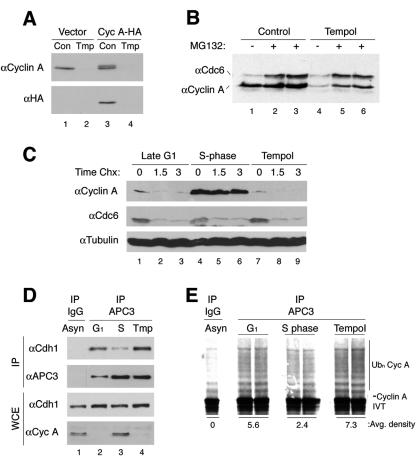FIG. 5.
Failure to accumulate intracellular ROS results in continued targeting of cyclin A for degradation by APCCdh1. (A) NIH 3T3 cells were infected with retrovirus-expressing HA-tagged cyclin A, serum starved, and then restimulated with or with tempol for 20 h. Cyclin A proteinfails to accumulate, due to degradation, when expressed from a long terminal repeat promoter. (B) T98G cells restimulated with or without tempol for 18 h were treated with either dimethyl sulfoxide or the proteasome inhibitor MG-132 for 1.5 h. Cdc6 was used as a control for the MG-132. Inhibition of the proteasome by MG-132 causes accumulation of cyclin A in antioxidant-treated cells. (C) T98G cells were synchronized as before and treated with cycloheximide at 16 (late G1) or 20 h (tempol and S phase). Cyclin A protein is stable in S phase cells but rapidly degraded in late G1 or antioxidant-treated cells. (D) Coimmunoprecipitation analysis of APC with APC3 (Cdc27) antibody shows high levels of Cdh1 associated with APC in G1 and antioxidant-treated cells. (E) In vitro APC ubiquitination assays where APC was immunoprecipitated from late G1, S phase, or tempol treated cells (as above in panel D). APC beads were incubated for 1 h at 30°C with 35S-labeled, in vitro-translated cyclin A, E2 (UbcH10), GST-E1, ubiquitin, and an ATP regenerating system. APCCdh1 remains highly active in G1 and antioxidant-treated cells.

